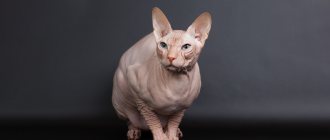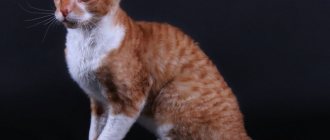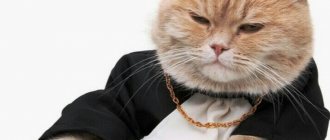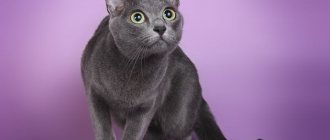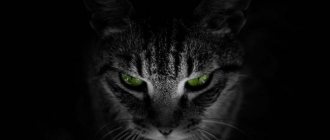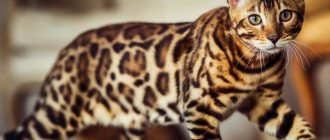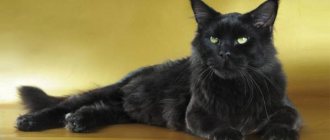general information
- Breed name: Siamese cat.
- Country of origin: Thailand.
- Weight: 3–5 kg.
- Height at withers: up to 25 cm.
- Average life expectancy: up to 15 years or more.
- Average price: from 1,000 to 20,000 rubles and more.
This is interesting: Characteristics of the Siamese cat
Main characteristics
Thanks to the unique coloring, the Siamese cannot be confused with other individuals. Pets have deep blue eyes and a rather intelligent and expressive look.
The weight of an adult cat is usually 4-5 kilograms. Animals that have undergone sterilization or castration can weigh 7-8 kilograms.
The height of cats is small and is 23-25 centimeters at the withers. The length of the body does not exceed 60 centimeters.
The color of these animals is unique. The main part of their body is light, and the tail, paws and muzzle are dark.
If you provide your cat with proper care and proper nutrition, its life expectancy can be 25 years.
The character of the Siamese cat is independent and stubborn. Cats are friendly towards both adults and children. They become very attached to their owner.
The Siamese have a highly developed intelligence. They are smart, quick-witted and calculating.
Siamese cats are very sensitive to the mood of their owner and can show jealousy towards him.
Despite the craving for loneliness, Siamese love cheerful company and are able to attract attention.
Speaking about the character of the animal, it is worth mentioning its touchiness. Getting forgiveness from a punished or offended cat is not so easy.
Varieties of Siamese also include the Oriental, Mekong Bobtail and Thai Siamese.
Appearance of a Scottish Fold cat
The history of participation of Scottish Fold cats in exhibitions is not so long. Today, there is one general breed standard that all Scottish Folds must meet. In addition, at major competitions, panels of judges use three types of official standards to evaluate animals: WCF, CFA and TICA.
The appearance of a Scottish Fold cat must fully comply with all the requirements of the general breed standard.
Head
Round, with a strong chin, thick round cheeks and a high forehead. The chin is massive and strong. For adult cats, sagging cheeks are allowed. The nose of a Scottish Fold cat should be wide and short.
Small to medium in size, with slightly pointed tips. They are located widely on the head. Folds forward and down. A special requirement is that when folded and pressed, they must fit into the contour of the head without protruding beyond its boundaries. There are three types of lop ears:
- single (only the ends are bent);
- double (the entire auricle is bent, the gap between the ears and the head is visible);
- triple (fully pressed, there is a visual effect of the absence of ears).
Eyes
Widely spaced and round, large in size. An important point is that the eye color must match the overall color of the animal.
Scottish Folds are characterized by a fairly short, muscular neck.
Torso and limbs
Scottish Fold cats have a medium-sized body, muscular and strong. Well-developed shoulders and chest are clearly defined. Limbs of medium length with developed muscles. The paws are small and round.
Tail
Size – from medium to long. At the base it is quite wide, gradually tapering to a rounded tip. Movable and flexible.
Wool
The cover is dense, elastic and thick. Due to its high density, it does not adhere to the animal’s body, and it looks fluffy.
Color
The Scottish Fold can have a wide variety of coat tones. The breed standard does not make any specific requirements in this matter. But when judges give marks at competitions, they will necessarily take into account the correspondence of the shade of six to the color of the eyes, nose and paw pads, for example:
- color six white. Eye color – golden or blue. Nose and paw pads are pink;
- the fur is pure black. The eyes are only golden. Nose – black, paw pads – gray or black;
- For a smoky-black color, paw pads that are exclusively black in tone are considered harmonious. The color of the eyes and nose is the same as for the pure black coat.
The variety of colors is one of the features that distinguishes Scottish Folds from other cat breeds, and certain requirements for compliance with the general range are imposed on each representative of the breed.
Scottish Folds are medium-sized cats. The weight of females is from 3.5 to 4.5 kg, males are larger - up to 6 kilograms.
The difficulty in choosing a Scottish Fold comes from the variations within the breed itself. Despite the name, Scots are born with both curled and straight ears. In addition, some kittens have not short, but semi-long hair.
Diseases and health problems
Every cat breed has health problems. The Siamese breed is no exception. A common problem for all cats is dental disease. Therefore, the cat needs to undergo hygiene procedures, in particular, oral care.
The weakest aspect of the health of the Siamese breed is the bronchi. It is strictly forbidden to keep a cat in a cold and damp room. The cat is subject to frequent stress and disruptions of the hormonal system. Against this background, neurodermatitis occurs.
There may be problems with the liver caused by improper diet of the pet. All representatives of the Siamese breed do not tolerate anesthesia well.
By gender, animals are susceptible to the following diseases:
- Males - disruption of the heart muscle;
- Females - tumor formation in the mammary glands.
Congenital diseases of this breed include the following:
- Curvature of the tip of the tail;
- Strabismus;
- Protrusion of the sternum.
All cats, regardless of whether they go outside or not, need regular vaccinations. A kitten should have its first vaccination at 12 weeks. In the future, it will save your pet from viral rhinotracheitis. At the same age, your pet can be vaccinated against rabies. The subsequent vaccination schedule should be drawn up by a veterinarian.
It is not recommended to vaccinate kittens during teething. Because in the future this could have an extremely bad effect on their offspring. Two weeks before vaccination, the cat must be dewormed and treated with flea and tick repellents.
Only completely healthy individuals can be vaccinated. After vaccinations, the cat must be closely monitored. If problems arise, you should immediately contact a veterinarian. With proper care, a Siamese cat lives on average 15 years.
How long do cats live at home?
If you have already decided on the type of future pet, then it would be nice to find out detailed information about it. An important point is information about how long domestic cats live. These animals are protected by shelter, warmth and other benefits of life with the owner from many unfavorable environmental factors. They do not need to fight for survival, look for food and a warm place, or protect themselves from other animals and people. Cats live at home for about 12-15 years, although there are also long-livers.
How long do barn cats live?
Cats that live in harsher living conditions live significantly shorter lives than their domestic counterparts. Street cats live on average no more than five, less often seven years. They freeze in the cold season and get wet in the rain, do not always have the opportunity to eat, and are susceptible to various diseases and parasites. In addition, frequent uncontrolled pregnancies in cats further shorten their lifespan due to various consequences of childbirth and hormonal changes.
The question of how long cats live on average largely depends on their living conditions. In even worse conditions are cats that lived for a long time with a person, and then were thrown out onto the street or ended up there themselves for some reason (ran away, got lost). Animals unadapted to harsh survival conditions in other aggressive environments live even shorter lives than street dwellers from birth. As a rule, their lifespan on the street does not exceed two years.
How long do purebred cats live?
It is believed that the lifespan of a cat depends not only on its surrounding conditions, but also on hereditary factors. How many years cats live at home depends on their breed. Many breeders are confident that purebred cats live shorter lives than their mongrel counterparts. This is explained by numerous genetic mutations during crossing. As a result, representatives of each specific breed, as a rule, have a stable set of hereditary diseases.
Scientists and veterinarians have no consensus on this matter. They tend to believe that the life expectancy of pets is influenced by many factors, including the psychological situation in the breeders’ family, the quality of food, and so on. Nevertheless, professionals in breeding purebred cats observe stable statistics. According to her figures, some breeds live 11-12 years, others about 15, and still others have long-livers, delighting their owners for 18 years or more.
How long do sterilized cats live?
The issue of sterilization is important as a factor determining how long cats live at home. The owner must make the decision to carry out the procedure as early as possible. If a cat is not sterilized and not mixed with cats, there is a risk of developing cancer. Frequent childbirth in an animal is also harmful, as it leads to rapid aging of the body and many vital organs. It has been noticed that cats after sterilization live on average 3-4 years longer than their counterparts.
Experts believe that in most cases, spaying or castration makes animals lethargic and less active. This often leads to obesity and diabetes, which also negatively affects the pet’s health and life expectancy. One way or another, it is better to solve this issue individually, based on the lifestyle and character of each specific animal. Competent consultation with a specialist will also help with this.
How long do mad cats live?
Rabies is a dangerous fatal disease of all warm-blooded animals. It can occur through contact between a domestic animal and a street animal or through infection during hunting for sick rodents. There are two types of rabies in cats.
- A pronounced disease may initially be masked during the incubation period. Bacteria multiply in the animal’s body within one and a half weeks. After about two weeks, the cat dies.
- Another form of the disease is silent. It can be distinguished if you know very well the character and habits of your cat and observe him. In such cases, the behavior of the furry pet changes to the exact opposite. An infected animal can live for several months without clear external signs of the disease or painful symptoms. To prolong the life of your cat, you should limit its access to communication with other people's animals.
Advantages and disadvantages of the breed
The positive characteristics of Siamese cats include:
- Magnificent mind.
- Excellent trainability.
- Loyal to their master.
- They have an attractive appearance. This can be seen by looking at a photo of a Siamese cat.
- They get along well with the smallest members of the family.
- Practically not subject to shedding.
- Playful and cheerful.
Pets also have disadvantages:
- Siamese are very touchy and can remember bad things for a long time.
- They are independent and have willful characteristics.
- Demanding about cleanliness.
- They do not tolerate cold well.
- They have a fairly loud voice.
- They are jealous and cannot tolerate cohabitation with other animals.
Appearance
The ears of such pets are widely spaced and quite large in size. With its elegant, aristocratic appearance, the Seychelles cat resembles a fragile figurine. But this perception is deceptive - she is resilient and strong. Her graceful, soft gait, full of dignity, reveals her as a native Englishwoman. And she is no stranger to royalty and willfulness. The heavenly gaze seems to penetrate into the depths of the soul and see right through. The exterior has characteristic features:
- The Seychelles cat has an average size and weight of 2-5 kg;
- The shorthair coat is longer on the belly, tail and shoulder girdle, and has no undercoat;
- Thin bone, well-developed muscles with a narrow chest;
- Slender, long limbs with neat paws - “pads”;
- Wedge-shaped elongated head with a narrow chin;
- The curve of the muzzle from the forehead to the nose is flattened;
- The ears are the “calling card” of the breed - large, widely spaced, with rounded corners;
- Almond-shaped eyes of any shade of blue, slightly slanted;
- A flexible, long tail that expresses the pet's emotions.
The color is pleasing to the eye
Such pets may have colored spots against the background of white fur. Color delights require special attention. According to the standard, the Seychelles coat should have a snow-white appearance with a point. The two-color “van” pattern is characterized by a white background with spots of a different color (black, red, gray). The tail is always multi-colored, often tortoiseshell. Based on the size and location of the spots, three types of color are distinguished. The Seychelles cat is distinguished by a mandatory feature - colored ears, paws, tail and mask. The mask does not take up the entire head.
Wayward character
Despite the rarity of the breed, people have already heard about the Seychelles. On the one hand, it is an intelligent, cheerful, active animal, on the other hand, it is a rebellious, stubborn creature.
The cat will try to subjugate other pets at home to its will and will not tolerate a fight for the owner’s attention. And she really needs it
These four-legged animals are obliged to enjoy universal favor and feel cared for and warm. Ignoring will lead to depression and illness. Selfishness forces the Seychelles to choose one of the family members as a favorite and bestow devotion only on him. However, cats get along well with children. All their lives (about 15 years) they are funny, playful and energetic. If someone dares to offend the “blue blood”, the animal will find a way to “revenge”.
A pet requires attention as a full-fledged member of the family. Over time, Seychelles dogs become pets and full members of the family, responding with friendliness, joy and affection to their owners for many years
Becoming the center of general pleasure, they bring a unifying principle into the house and develop discipline and responsibility. Talkativeness will prevent you from getting bored and sad.
Rules of care
Siamese cats are practically easy to care for.
Due to the lack of undercoat, they do not require combing at all. There is no particular need to bathe them, especially since Siamese do not tolerate low temperatures.
Eyes and ears also do not require special attention. You should only occasionally remove visible dirt from the eyes and ears.
Only the oral cavity requires close attention, since representatives of the breed often suffer from dental diseases. According to the recommendation of veterinarians, you should brush your cat’s teeth at least once a week with a special brush and paste.
The Siamese's diet must contain meat, offal, fish, eggs, vegetables, and cereals.
The Siamese breed is quite popular, so purchasing a kitten will not be difficult at all. How much does a Siamese cat cost? Its price directly depends on the availability of documents, class, pedigree and color and varies from 7,000 to 25,000 thousand rubles.
This is interesting: Description of the breed and character of Siamese cats
Feeding
Experienced breeders recommend feeding this breed with premium balanced dry food without changing the brand.
- When choosing food from natural products, you need to consult a veterinarian, who will advise what products and in what quantity to give in order to get a balanced and healthy food.
- At the same time, we must remember that you need to feed the cat either natural products or dry ones, since with a mixed diet the pet can get urolithiasis.
- Start feeding a small kitten six meals a day, and gradually, as they grow older, increase it to two meals a day.
Varieties
Manufacturers distinguish several varieties of Siamese cats:
- True Siamese are distinguished by a narrow muzzle, increased thinness, large triangular ears, long paws and the same tail.
- Thai cats are very similar to Siamese, but have a dense body, rounded smooth lines and fluffiness.
- The Oriental breed has no points. Solid or spotted color, thinness is what distinguishes them from the Siamese representatives of the breed.
- The Mekong Bobtail is very similar to the Thai breed, but their tail is much shorter and wider.
Due to their particular popularity, breeders are working on creating new breeds of Siamese cats. Among them are the following types:
- Siamese-Persian cat. She is too beautiful and has a unique character. Beautiful blue eyes and Siamese coloring - these characteristic features are combined with long hair, which is unusual for other species.
- Burmese cat. Very similar to purebred Siamese, but her coat is semi-long, with the same darkening. It has white socks on its toes and paws. In terms of physique, it is absolutely no different from its Siamese relatives.
- Neva masquerade cat. She was bred by Russian breeders. It has a long, smooth coat and characteristic dark markings. The masquerade cat was created by crossing a Siberian species and a Siamese. They do not like loneliness and monitor the mood of their owners.
- Snow shu. It is distinguished by its point color with white tips on its paws. This breed was obtained by crossing a Siamese and an American Shorthair.
- Seychelles. Has a bicolor color. Representatives of this breed are elegant and slender, almost bald, but with a slight undercoat, their front legs are shorter than their hind legs. Too capricious and frivolous.
Also, as a separate subspecies, the fold-eared cat can be distinguished, which is very rare. The lop-eared pet is similar to the British breed, but differs in color and wayward character.
Standards
Siamese cats can be called miniature: both males and females rarely weigh more than 5 kg (6 kg is already a unique case). The dimensions are average: the length of the cat is about 65-70 cm, the height (measured in the area of the shoulder blades) is up to 30 cm.
| Standard | Description |
| Head | Wedge-shaped, the muzzle tapers noticeably from the nose to pointed, broad-based ears, visually resembling a triangle. |
| Eyes | Small, almond-shaped, set slightly obliquely. The iris of the eyes should be colored only blue (of varying brightness). |
| Torso | Flexible, slightly elongated, anatomically proportional. Well-defined muscles add grace and strength to the appearance. Both the front and hind legs are long and thin, the hind legs are somewhat longer than the front ones. The lower part is elegantly rounded, medium in size. |
| Tail | The length of the tail is 27-28 cm. It is elastic, thin and pointed. |
| Wool | Short and very dense, there is no undercoat completely. |
Expert opinion
Dusheba Vera Ivanovna
In 2010, she graduated from the Moscow State Academy of Veterinary Medicine named after K.I. Scriabin with honors, specializing in veterinary medicine. I regularly attend veterinary conferences, congresses, and webinars.
When planning to buy a Siamese kitten, contact nurseries with a good reputation and reputable breeders. This way you will get a genetically healthy and purebred animal. It would be ideal to observe the baby's parents. Remember: kittens are born with light-colored, monochromatic fur, and spots will appear much later. Be sure to try to make contact with the kitten: play with it, call it in your arms. If he shys away from people, runs wild, hides in corners or hisses, the likelihood that he is simply scared is extremely small. Most likely, his character in the future will not please you. A healthy kitten has a good appetite and regular bowel movements, no mucous discharge from the nose or eyes, and the tummy is not bloated. He is active and curious. A kitten not for breeding can cost 6-7 thousand. If you buy an animal for exhibitions, you will have to pay at least 27 thousand rubles for it. A Siamese “for breeding” costs from 50 thousand.
When kittens start to get dark
All Siamese kittens are born albinos, but after a week characteristic spots begin to appear, by six months it becomes clear what the main color of a Siamese kitten is, and by the 10th month all shades are finally formed.
Dark shades appear on the paws, tail, ears and face. With age, the contrast intensifies.
What age is best to take
The kitten is not separated from its healthy mother for at least two months: during this time, it drinks its mother’s milk, rich in antibodies, and strengthens its immunity. Early (at 1 month) separation from a cat is fraught with stress, which negatively affects the health of babies. It is preferable to select a Scottish Fold in the range from 3 to 9 months, in the so-called adolescence. At this time, the “Scots” become long-legged, slightly awkward and stretched out, like all teenagers: against this background, the breed’s shortcomings clearly appear.
If by this age the baby still has large ears, a loose undercoat and a thin tail, do not entertain the illusion that the ears will shrink, the undercoat will grow, and the tail will become shorter and thicker. An exemplary “teenage” Scottish Fold has a thick muzzle, powerful paws, small neat ears, “stuffed” hair and a not particularly long tail.
Mister Cat warns: differences between Siamese and Thai cats
The modern Siamese cat differs significantly from its ancient ancestor in terms of standard. She is sleeker and more like an oriental type. The Thai cat is an Old Siamese variety. The differences between the ancestor and the new type are significant.
On the left is a Siamese cat, on the right is a Thai cat
The body and head of the Thai are more rounded and less refined, the ears are not so widely spaced, and the eyes are rather round in shape. In some systems, this variety is identified as a separate breed, in others it is a subtype of the main species.
Thai kittens
There are also differences in character - there is no Siamese arrogance, these are softer and more obedient pets, selfless and devoted, but just as energetic and active.
Breeds developed using the Siamese cat
The Siamese cat fascinates with its elegance, unusual characteristic color-point color and sapphire eyes. Breeders of many cat lines are tempted to introduce these peculiar traits into their pets. As a result of breeding work based on the Siamese, the following breeds appeared:
- Australian;
- Burmese - short-haired Siamese without points;
- Balinese - Siamese and Angora combined with a long-haired Siamese;
- Himalayan (Khmer) - Siamese and Persian, fluffy mestizo with color-point color;
- jungala;
- California Speckled - Abyssinian, Siamese, British and American Shorthair, Manke, Persian, African and Asian street cats;
- Ocicat - Abyssinian and Siamese;
- snow-shu - Thai type in white socks;
- Neva Masquerade - Siamese and Siberian;
- Tonkinese - Samskaya and Burmese;
- Javanese - Siamese and Abyssinian.
Upbringing
By the time they move to a new home, Thai kittens have already mastered the basic rules of behavior well and know how to use a scratching post and litter box. To make the process of getting used to a new place of residence quick and painless, try to create an environment for your baby that is similar to the one in which he spent the first months of his life. Talk to your pet calmly, without raising your voice unnecessarily. A Thai will quickly understand that if they are dissatisfied with him and loudly scold him, then he has really done something wrong. Keep the use of harsh measures to a minimum. Aggression can only breed aggression. You can calm an overly angry cat with a stream of cool water. This is not painful or humiliating for the royal cat, unlike physical punishment.
Provide your baby with enough toys. This will distract him from mischief and protect your things from damage. Keep valuable items and papers out of reach of the animal.
Having a cat in the house is both a great joy and a huge responsibility. And this responsibility lies with the individual.
Choosing a kitten and cost
The cost of a kitten varies from 200 to 800 dollars, depending on the purpose of the purchase. A pet-class kitten is cheaper, but has no pedigree and can only be a pet. For breeding work and an exhibition career, it is necessary to choose a blue-eyed baby with a good pedigree and excellent health.
The price of individual pedigree cats can exceed a thousand dollars.
All kittens from the nursery must be accompanied by veterinary passports with notes from the state veterinary clinic on vaccination against rabies and all known feline infections.
Color classification
The most common color of the Scottish Fold cat is blue-gray. Currently, the variety of colors is very large, so the coat can be of almost any color. In order to obtain such a wide variety of colors in the Scottish Fold breed, crossings were initially carried out with several other breeds.
This is interesting! Today, the breed already has all the necessary gene set, so such crossbreeding activities are not encouraged.
In total, the Scottish Fold has a predominant pair of genes that are responsible for the red and black coat colors. The dominant and recessive genes are supplemented by the so-called “diluent”, which is responsible for the richness of the coat color. The result of the combinatorial function is the production of animals with a variety of coat colors.
It should be remembered that it is practically impossible to reliably determine the color of a Scottish kitten immediately after its birth, since the main color appears only after the first coat is replaced by an adult coat, that is, at the age of six months.
Plain
The presence of a solid color implies the complete absence of any inclusions of a different color. The coloring of the coat should be rich and as uniform as possible along the entire length of the hair. The presence of inclusions of any other color suggests a different color or is regarded as a defect, which helps to reduce the value of the animal and negatively affects exhibition ratings.
The solid or solid color of the Scottish cat can be blue or so-called grey, black or “ebony”, white, chocolate or brown, lilac, fawn or light lilac, cinnamon or “cinnamon”, as well as red and cream.
This is interesting! The classic color is considered to be blue, but in recent years, domestic pets of the Scottish Fold cat breed with lilac and cream coat have become widespread.
Bicolors
Bicolor is a popular coat color characterized by snow-white coloring over a large area of the coat. White color must be present in the abdomen, chest, neck and chin, as well as limbs and muzzle. The distribution of other shades is uniform, without a local pronounced predominance.
In accordance with breed standards, there must be a mark on the animal’s face that looks like an inverted Latin letter “V”. Animals that have an open-type white “collar” in the neck area are especially highly valued. Combinations of white with blue, cream and red tints, as well as with any tabby colors, are especially popular.
Particolor
The coat color called particolor or calico is a very interesting combination of the classic snow-white color with the original tortoiseshell color.
Scottish fold cats with a van or “van” color are especially popular among foreign breeders. In such pets, the basic coloring is exclusively on the tail, but there are several spots in the head area.
Animals with blue markings or cats with the “blue van” color are very popular. This option is characterized by the presence of a pair of small spots on the paws or body of the pet.
Harlequin color
Scottish fold cats with a harlequin color are among the most sought after in our country . This is one of the types of coat color of Scottish cats, characterized by the presence of white spots with a special type of distribution. The color can contain from 50% to 80-82% white, which allows animals with a similar coat to be classified as an intermediate type of white distribution between the “van” and “bicolor” colors. The main characteristics of the “harlequin” color are presented:
- white chest, paws and neck;
- fully colored tail;
- several clear, large or medium-sized spots of different shapes on the back, head and croup.
